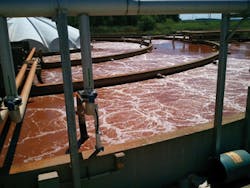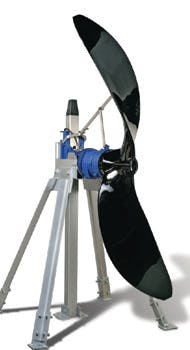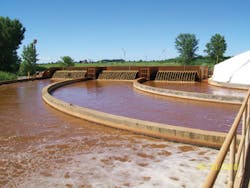By Todd Hammond, Tom Bachman, and Jon Butt
Grande Cheese Company is a Midwest producer of Italian cheeses and related dairy products. The Brownsville, WI, plant is Grande's largest of four production facilities. The main product from the Brownsville facility is mozzarella cheese. Grande wanted to add a new high strength wastewater anaerobic digestion treatment system to eliminate the practice of hauling and land application. The anaerobic system would also produce biogas that could be used to offset natural gas demand within the production plant. Liquid waste from the new anaerobic system would go to the existing waste treatment system for additional processing.
The heart of the existing wastewater treatment system is a three-ring oxidation ditch (OD) with a center circular clarifier. Ring 1 is the inner ring sharing a common wall with the clarifier, ring 2 is the middle ring and ring 3 is the outer ring. Flow can be directed into any of the three rings but normal operation has flow entering ring 3, then into ring 2, then into ring 1. Mixed liquor leaves the OD and flows to the center clarifier. Effluent from the clarifier flows to a phosphorus removal process and then discharges to a receiving stream. Solids collected in the clarifier either return to the influent of the OD or to a dissolved air floatation unit for thickening and disposal.
The oxidation ditch used rotary disk aeration. The number of disks varied in each ring. The disk aeration system was able to meet the process oxygen requirements from late fall to early spring. Figure 1 shows the dissolved oxygen concentration for all of 2009. The pattern shown is typical of most years. The disks over aerated during the winter and under aerated at times during the summer. The plant in the summer of 2010 added additional aeration to increase dissolved oxygen concentration levels. Any additional load coming from the new anaerobic system would burden an already overloaded system. More aeration was needed either by adding more aeration or investing in a new system to handle increased loads.
Working with its design engineer Symbiont, Grande identified the features needed from any aeration system addition:
1. Dissolved oxygen concentration in the summer needed to reach a minimum of 2 mg/L in ring 1 and above zero in ring 3.
2. Any new equipment had to be installed without interrupting cheese production.
3. A goal of providing the process oxygen with the same or less horsepower than the existing system.
The existing aeration system capacity was estimated at about 457 pounds of oxygen per hour (clean water) based on literature from the disk equipment manufacturer. Plant records indicate the energy consumption of the disk aeration system at about 105 kW. Additional aeration in 2010 was provided by a floating aerator approximately 9 months of the year at an energy consumption of 13.4 kW. Total power of the system during the summer was 118.4 kW.
A process oxygen demand of about 904 lbs of oxygen per hour was developed by using plant production projections and estimates of the loading from the new anaerobic system. This design target for a new aeration system was well above the capacity of the existing equipment. If the existing disk aerators were to be used, it would be necessary to nearly double the number of disks. Adding additional disks would require additional horsepower making it difficult to meet the energy goal. Other mechanically aerated equipment (floating aerators, brushes, etc) would also require much additional horsepower.
A new fine bubble aeration system of diffusers, mixers, and blowers could meet the new process oxygen requirements and possibly meet the energy goal. The advantages associated with a new fine bubble aeration system were significant enough that it was decided to investigate a way of installing the equipment without interruption of the production process.
Detailed designs were prepared to get better estimates on the equipment requirements. An early decision involved decoupling oxygen supply and mixing. This was accomplished by using large slow speed horizontal mixers commonly called "banana blade" mixers (because of the shape and size of the mixing blade). These mixers are very efficient; generate excellent thrust to provide horizontal velocity in the ditch to keep the mixed liquor suspended. Decoupling mixing and aeration allowed each to operate independent of the other providing the plant with more control and allowed for more flexibility when installing the fine bubble diffusers because the diffusers were not needed to mix.
Working with equipment suppliers, the design of the new aeration system evolved into three components: mixers, fine bubble diffusers, and air supply blowers.
Mixers
The three rings of the oxidation ditch are concentric. The width of each is the same at 20 feet but the radius varied. The concentric ditch arrangement impacted the mixer design. After several iterations, the final design was selected that was based on two mixers per ring, each identical in size. The speed of each mixer would be controlled with a VFD.
Each mixer is mounted on a mast. A portable hoist is used to retrieve the mixers for routine maintenance or if a location adjustment is needed. The base of each mast is secured to the floor of each ring. Each mixer was located close to an existing walkway.
Fine Bubble Diffusers
To provide the most flexibility, it was decided that only membrane fine bubble diffusers would be considered. Membrane diffusers allow the air to be turned off without affecting performance. The proposed design was based on the diffuser being assembled in grids then lifted into place. Membrane disc type designs featured a steel base frame with concrete ballast. The base frame protected the air distribution piping during lifts.
Membrane tube type designs used the air supply piping as the frame providing significant advantages in cost and time to construct. A membrane tube system was selected. Multiple iterations were necessary in an attempt to determine the total number of grids needed and their approximate locations.
Stainless steel air distribution piping was to be installed along the top of the rings. Flanged connections for each grid would be located as necessary. Flexible hoses were used as droplegs for ease of installation. The final design also included space for adding more grids in the future should process conditions change.
Blowers
One of the main considerations for selecting the blowers was efficiency. Variable speed single stage turbo blowers are highly efficient and would help the plant minimize energy consumption. Several design criteria were considered. First, the blower needed to have a wide operating range because of load fluctuations for the cheese production line and seasonal impacts on process conditions. Second, it was desirable for the blower to be energy efficient throughout the operating range. Finally, the total package needed to provide enough redundancy to allow for normal maintenance and repair of equipment.
The final design was based on three blowers, each equal in size. All blowers included VFDs to allow operation from approximately 50% to 100%. Two blowers would supply future production plant waste loading requirements along with new loading from the anaerobic treatment effluent. In the advent of anaerobic pretreatment upset, all three blowers would be capable of providing enough oxygen to maintain aerobic conditions until the upset was resolved. A small amount of air is also being used by a new coarse bubble re-aeration system to help elevate dissolved oxygen levels after the clarifiers prior to effluent discharge to the stream.
Installation
With all the equipment selected for the new aeration system, a construction sequence was developed for installation of the equipment. The total sequence for installing the aeration system was 12 weeks. But it became apparent very quickly that was optimistic.
First, the air distribution piping was installed, then the mixers. Industrial underwater divers did the installation work; drilling anchors holes, setting concrete anchors, securing the base for each mixer, and clearing debris that might be in the way. A template was made from the mixer base to act as a guide for drilling the holes because the divers could not see in the mixed liquor.
The disks had to be off while the divers worked. Plant staff controlled when installation could proceed based on treatment plant conditions. The disks could only remain off for several hours at any one time.
Drawings of the ditch were available but it was discovered that several obstructions were not shown. The divers worked slowly and steadily until the mixer installation was complete. While the divers installed the mixers, the blowers were set in place and connected to the air main.
The diffuser manufacturer assembled the aeration grids in a lay down area next to the ditch. Assembly of the grids was completed before lifting began. Once again, the existing disks were turned off when grids were set in place. Obstructions on the ditch floor had to be removed in order to make sure that the grids were installed as level as possible. As an example, it took more than 10 hours to remove a submerged concrete support 36" x 24" x 14". With obstructions in the ditch removed installation of the aeration grids was finished in less than 11 days.
Results
The new aeration system has been operating since June 2011. As the staff has gained experience with the new system, they have been able to reduce large changes in dissolved oxygen levels. The annual energy usage increases in 2010 because of the added supplemental aeration equipment for nine months of the year. Energy consumption was not computed for 2011 because of the switch from the old aeration equipment to the new.
Loading to the ditch has increased since 2009 by over 15%, but the new aeration system is using significantly less energy based on annual estimates and energy consumption per pound of organic loading. Comparing the annual aeration energy values indicates nearly a 35% reduction between 2010 and 2012. The energy consumption per pound of organic shows a 36% energy reduction.
Operations staff also have noticed several process benefits beyond the energy reduction. Staff reports the mixed liquor settles better, they have not had any filaments, no oil on the ground, no overspray, less cooling of the mixed liquor in the ditch during the winter, and better DO control in each ring of the ditch.
About the Authors: Todd Hammond, CEM, is a senior project engineer for Grande Cheese Company, headquartered in Lomira, WI. He manages many of the capital projects for the company at its production plants. Hammond also leads the company's energy reduction efforts. Tom Bachman, P.E., is a Vice President and Senior Project Manager at Symbiont. He has been involved in a variety of water, wastewater and mechanical engineering projects for both municipal and industrial clients since 1986. Jonathan Butt, P.E., is a project and process manager at Symbiont working with municipal and industrial clients to develop solutions to improvements environments. He specializes in wastewater treatment including aeration systems, biological processes, and energy efficiency.




